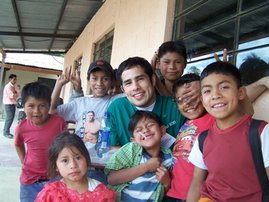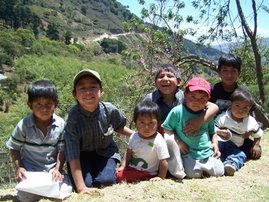1. Expectations that this day would be better and more productive than the last; rumors of generators buoyed hopes that the dental team would be able to do more than just extractions.
2. A larger team due to the arrival of four more bodies. A few team members had arrived early on in the week, but the largest contingency made the trek from Portland to Antigua on Wednesday. On Thursday the remaining team members arrived and were ready to work on Friday – Asher Paquette and Casey joined the medical team and Ben Gonzales and Mike Harper bolstered the ranks of the dental team.
3. An excellent breakfast of mixed fruit, followed by a ham-and-cheese omelet.
Up on the hillside in Vuelta Grande, the situation had little changed. There were a few villagers milling about the school yard when the team arrived, but there were still problems with the electricity.
Nevertheless the clinics swung into gear.
 The dental clinic started in on extractions again, the only procedures they could comfortably do under, in Dr. Allen Methven’s words, “flashlight dentistry” conditions. Typically the dentists’ work in the village consists of either pulling teeth or filling cavities; the latter requires drills, suction and the water sprayer – staples in dental work that require power. The school’s power finally steadied out by three o’clock in the afternoon, allowing the dentists to fill cavities, but until then they stuck to pulling teeth.
The dental clinic started in on extractions again, the only procedures they could comfortably do under, in Dr. Allen Methven’s words, “flashlight dentistry” conditions. Typically the dentists’ work in the village consists of either pulling teeth or filling cavities; the latter requires drills, suction and the water sprayer – staples in dental work that require power. The school’s power finally steadied out by three o’clock in the afternoon, allowing the dentists to fill cavities, but until then they stuck to pulling teeth.The addition of Ben and Mike to the dental team quickly turned the atmosphere into that of a teaching clinic; both Ben and Mike are second-year dental students at the Oregon Health Science University and were eager to practice their skills. Under the watch of Dr. Allen and Dr. Jim Ransom, the two were allowed to help with administering anesthesia and even performed the simpler extractions – a first-time experience for both.
For most cases, particularly in the afternoon when the cavity-filling began, the dental students acted as assistants. Both Dr. Allen and Dr. Jim would talk through their processes with the students, offering tips on everything from the procedure itself to how to most efficiently pass instruments from assistant to dentist.
The environment is an ideal one for learning. Not
 only are the students able to work with experienced dentists, but the villagers are model patients. The Guatemalans sit quietly in their dental chair and, no matter their age, scarcely whimper and rarely cry out. Their stoicism is remarkable.
only are the students able to work with experienced dentists, but the villagers are model patients. The Guatemalans sit quietly in their dental chair and, no matter their age, scarcely whimper and rarely cry out. Their stoicism is remarkable.Their silence may be in part a result of the language barrier between them and the dentists. For as much as this barrier becomes a challenge in communicating when and where the pain is, which tooth is irritated, or how to follow post-procedural care, the barrier became something of an asset in the teaching environment. The dentists were able to offer candid advice – like how to prepare a syringe out of the patient’s sight to keep them from getting nervous – and the students were able to ask frank questions and call for assistance without making their patient nervous.
While the students were getting hands-on experience, Maureen Gonzales, who usually assists in the dental clinic, went down the hall to the medical clinic to offer some of her own hands-on experience. Maureen is a physical therapist and was able to spend some time working with a woman who had come in to the clinic complaining of muscle stiffness.
Maureen speculated that the 43-year-old woman was simply feeling the effects of carrying heavy loads on top of her head while carrying children on her back and spending much of her time hunched over at her work, be it making tortillas or doing the laundry.
“Her daily workload over the years is taking a toll on her body,” Maureen said.
Maureen did some massage work as well as some “joint mobilization” and stretching with the woman, as well as teaching her some exercises she can do at home.
“She was uncomfortable with the idea of doing exercises,” Maureen noted. She added that because the idea of physical therapy and proper ergonomics are largely foreign to this woman and that “they have to see that there’s a benefit to it.”
Because there is no real opportunity for follow-up or to continue working with the woman, it will be hard to know what will really help her. Nevertheless, Maureen’s efforts seemed to make a difference.
“She felt better at the end of the therapy,” Maureen said.
The clinics began to wrap up around four o’clock, driven by the need to make the drive through the winding mountain roads while there was still daylight. There is one main road that leads through Vuelta Grande and goes down to Antigua; it’s paved, but is almost impossibly steep and consists of several harrowing switchbacks, all of which are unlit. But the trip also offers incredible views of the fields etched into the mountainside and of the nearby volcanoes, crowned with thick white clouds.






No comments:
Post a Comment